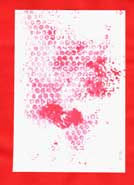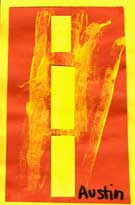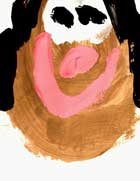 |
||||
| College of Education Home | News & Events | Make a Gift | UW Alumni | ||||
|
April 2011 | Return to issue home
At EEU: The Importance of Art for All Students Art projects are incredibly useful for guiding early childhood curriculum. At the Experimental Education Unit, a birth through kindergarten program where children with and without disabilities learn together in inclusive environments, the special education teachers have traditionally used art to help students meet specific goals.
In the past, art projects were primarily used to promote a structured skill, such as learning to cut or to draw a straight line. These can be challenging skills for some learners with disabilities, especially for kids who might refuse to touch a paintbrush. Yet the EEU was missing an element of inspired creativity within art projects that encourages self-expression and imagination, while laying down the structural building blocks for developing basic skills. As Susan Sandall, associate professor of special education, explains, "Art activities allow young children to express their creativity and imagination. A comprehensive curriculum for young children includes opportunities for creative expression through art and other means. A comprehensive curriculum doesn't limit the children or their teachers to early literacy and early numeracy and other well-known domains. Rather, children have opportunities to express themselves and at the same time learn and practice such important skills as observation, attention, problem-solving and using their hands, just to name a few. It is the skillful teacher who can both help young children learn to use the materials or media and also enable children to explore, experiment and gain some control over the media."
At a school where instruction is individualized for all children, it can be challenging for teachers who have primarily been trained as special educators to develop art tasks with the inspirational creation that comes from within. Recognizing this area of improvement for the school, the leadership team at the EEU worked with Lisa Matsumoto, EEU staff member and parent, to develop training and support around incorporating art into the curriculum in a more meaningful and authentic way. Matsumoto has taken the lead on the EEU’s latest project, The Inclusion of Art, by working with each individual classroom team to help them incorporate art into the classroom. "I realized that EEU teachers were so focused on basic skills, that we hadn’t tapped into the motivational elements of art," Matsumoto explains. "Sure, let's help a kid work on cutting skills. But first we should talk about what the child wants to do artistically and work on cutting skills within that goal." Yet while "doing art" can mean many things, in classrooms where teachers balance the needs of many different types and levels of learners, incorporating art as a philosophy can be tricky. How does each teacher or classroom inspire artistic vision in his or her students? Matsumoto focused on expanding the teachers’ understanding of how art can be used both as a tool in the classroom and as a core curricular component. "Art can be used as a method of motivation, a way to enhance curriculum and is simply a core area of learning for all students," Matsumoto asserts. "It can provide students with a range of possibilities not only in acquiring new learning but also expressing and communicating their knowledge. Modifying the curriculum through art allows children to participate in the same activity together and allows the teacher an opportunity to provide an appropriate level of challenge for the experienced artist and the child who is just picking up a brush for the first time. For special education teachers, art activities provide opportunities to work on individual goals for students in motor, communication, social and cognitive domains."
At the EEU, these art activities start with the teachers. After all, they’re the leaders who need to incorporate art into their classroom plans. As Fanny Yang, head teacher of the morning ECEAP class at the EEU, explains, "We have used art as a medium for exploring, representing, and documenting our investigations and learning. For example, the children learned about aspects of construction (e.g. foundation, symmetry, support) through making their own constructions out of various materials; they observed and documented the growth of their potato plants by making still-life drawings of them. We have also delved into art itself as a topic, discussing how one can make art—materials, techniques, and two dimensions versus three dimensions." Matsumoto provided training for the teaching staff, but it was the many dedicated and passionate educators at the EEU who translated their learning into true curricular change at the EEU. For example, the DATA Project team, began by examining the basic supplies and how they might develop curriculum plans. But they quickly ran into one problem that may be unique to their team. Some of their students refused to touch paintbrushes. While this may seem like a simple dilemma, this problem motivated the teachers and, eventually, the students to think in different ways. They threw the brushes out and started using alternatives for painting. Now DATA Project kids paint with tools like kitchen utensils, fruits and vegetables. The teachers are incredibly grateful for Matsumoto’s leadership and for the benefits that the Inclusion of Art has brought to their students. "Lisa's support has been incredible," says Angela Erickson, kindergarten teacher at the EEU. "I have been teaching kindergarten for four years, and this year is the first time that I have felt confident and comfortable creating opportunities for art in the classroom. I am in awe of what my students have created, and very excited to see what they continue to create…We now have an 'art class' every Tuesday morning, but we have also incorporated art at other times of the day." And the community has certainly taken notice. "The best thing has been the parent interest in our projects," Ariane Gauvreau, Project DATA Head Teacher, effuses. "It’s great to see them so impressed with their students' art hanging in the hallway! Additionally, we serve students who have fairly severe disabilities and require a lot of adult support throughout the day. It's great when those students have art framed and hanging in the hallway, just like their typically developing peers do. This is another way of ensuring that all students are part of our school community and represented throughout the building. And I love sending home art that looks like real art!" And that is the most important lesson that has come from the Inclusion of Art: All children’s art should be honored and respected. April 2011 | Return to issue home | ||||
|
||||


